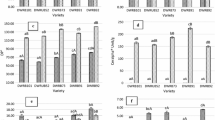Abstract
Wheat of two strong high-protein and two weak low-protein cultivars from New Zealand and Australia were milled to commercial specifications. All millstreams were tested for α-amylase, β-amylase, falling number, protein, starch, damaged starch, amylose, amylopectin, pentosan and ash. The distribution of β-amylase in millstream flours was more variable among cultivars than α-amylase. Generally, both enzymes had lowest activity in sizing and early reduction flours. α-Amylase was very high in the bran, pollard and germ fractions, in which ash content was very high, whereas β-amylase was low in these fractions. These observations, together with the moderate correlation of α-amylase and poor correlation of β-amylase to ash content, suggest that most α-amylasein flour derives from contamination with bran, pollard and germ, whereas most β-amylase derives from the endosperm. Falling numbers varied between the cultivars, but variation amongst millstreams for each cultivar was low, except for cv. Frame, which had particularly high falling number values (834 and 1197) in second and third break flours. These two flours had some of the highest α-amylase levels and lowest starch levels. However, they also had very high protein content (22 and 26%) and very low starch damage (3.2 and 4.5%), which may contribute to the high falling numbers. When endogenous α-amylase in the flour with the highest falling number was supplemented with high levels of barleyα-amylase, the flour withstood the detrimental effects of α-amylasein baking (sticky crumb, poor crumb texture and loaf volume) better than flours of lower falling number, but did not withstand the effects ofα-amylase on falling number.
Similar content being viewed by others
References
AACC, 1995. American Association of Cereal Chemists 'Approved Methods of the AACC', 9th edn, Method 56-81B, approved 1972, revised 1982 and 1992, reviewed 1994; Method 76-30A, approved 1969, revised 1972, 1982, and 1984, reviewed 1994; Method 08-01. The Association, St Paul, MN.
Batey, I.L. & B.M. Curtin, 1996. Measurement of amylose/ amylopectin ration by high-performance liquid chromatography. Starch 48: 338–344.
Douglas, S.G., 1981. A rapid method for the determination of pentosans in wheat flour. Food Chem 7: 139–145.
Every, D., J.A. Gerrard & M.J. Gilpin, 1995. α-amylase activity in commercial gluten. J Sci Food Agric 69: 257–263.
Graybosch, R.A., Gang Guo & D.R. Shelton, 2000. Aberrant falling numbers of waxy wheats independent of α-amylase activity. Cereal Chem 77: 1–3.
Holas, J. & K.H. Tipples, 1978. Factors affecting farinograph and baking absorption. I. Quality characteristics of flour streams. Cereal Chem 55: 637–652.
Kruger, J.E., 1981. Severity of sprouting as a factor influencing the distribution of amylase levels in pilot mill streams of Canadian wheats. Can J Plant Sci 61: 817–828.
Kruger, J.E. & K.H. Tipples, 1980. Relationships between falling number, amylograph viscosity and α-amylase activity in Canadian wheat. Cereal Res Com 8: 97–105.
Larsen, N.G. & D.R. Greenwood, 1991. Water addition and the physical properties of mechanical dough development doughs and breads. J Cereal Sci 13: 195–205.
Lukow, O.M. & W. Bushuk, 1984. Influence of germination on wheat quality. I. Function (breadmaking) and biochemical properties. Cereal Chem 61: 336–339.
McCleary, B.V. & H. Sheehan, 1987. Measurement of cereal α-amylase: a new assay procedure. J Cereal Sci 6: 237–251.
Mitchell, T.A., 1968. Hagberg Penetrometer method for α-amylase activity in sprouted grain: prediction of activity of flour blends. J Sci Food Agric 19: 102–105.
Moot, D.J. & D. Every, 1990. A comparison of bread baking, falling number, α-amylase assay and visual method for the assessment of pre-harvest sprouting in wheat. J Cereal Sci 11: 225–234.
Pomeranz, Y., 1988. Chemical compostition of kernel structures. In: Y. Pomeranz (Ed.), Wheat Chemistry and Technology, pp. 97–158. American Association of Cereal Chemists, St Paul Minnesota, USA.
Simons, E.D., 1928. The cash value of improvements to millers and farmers – further economies still conceivable. Milling June 30 1928: 801–816.
Author information
Authors and Affiliations
Corresponding author
Rights and permissions
About this article
Cite this article
Every, D., Simmons, L., Al-Hakkak, J. et al. Amylase, falling number, polysaccharide, protein and ash relationships in wheat millstreams. Euphytica 126, 135–142 (2002). https://doi.org/10.1023/A:1019699000975
Issue Date:
DOI: https://doi.org/10.1023/A:1019699000975




